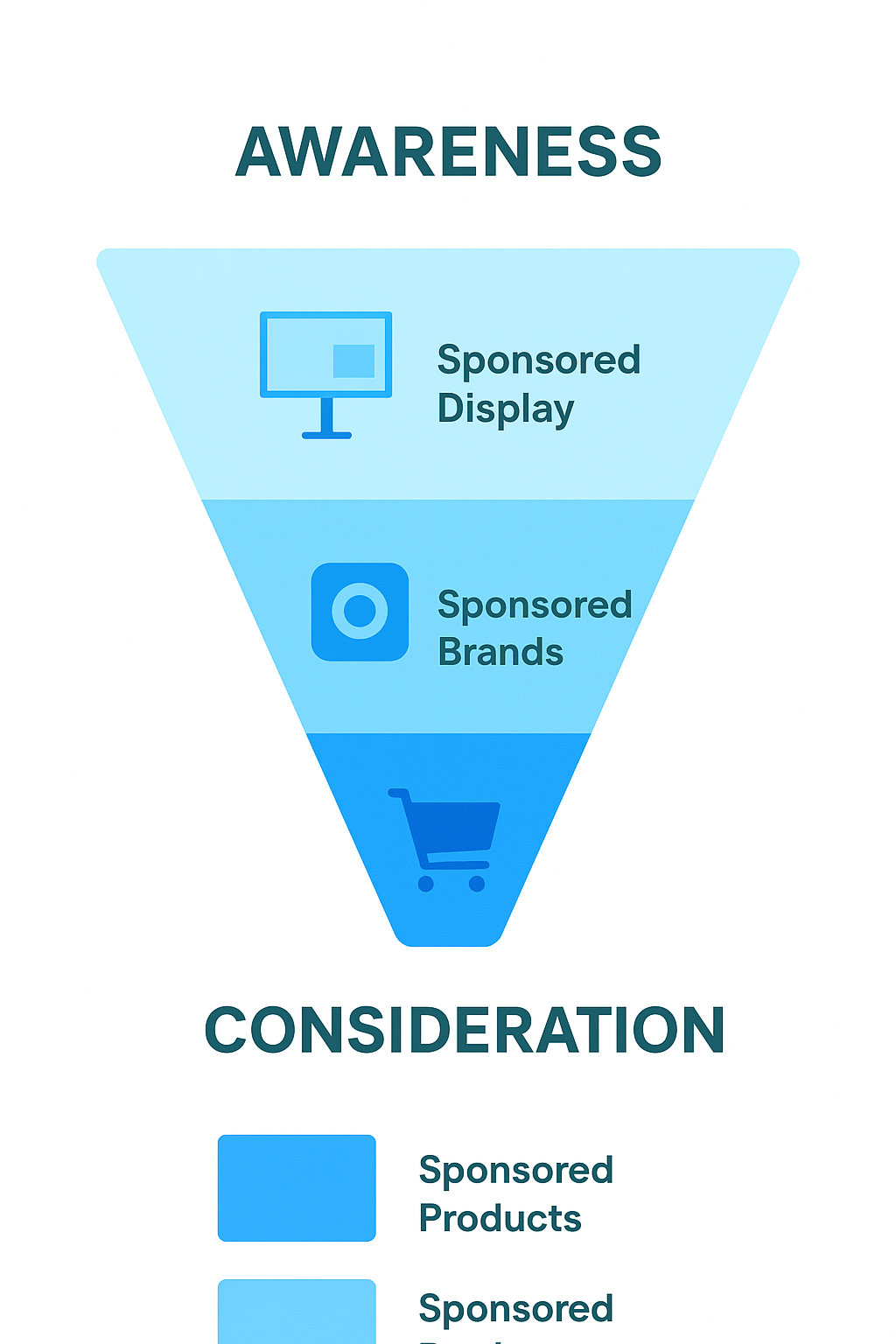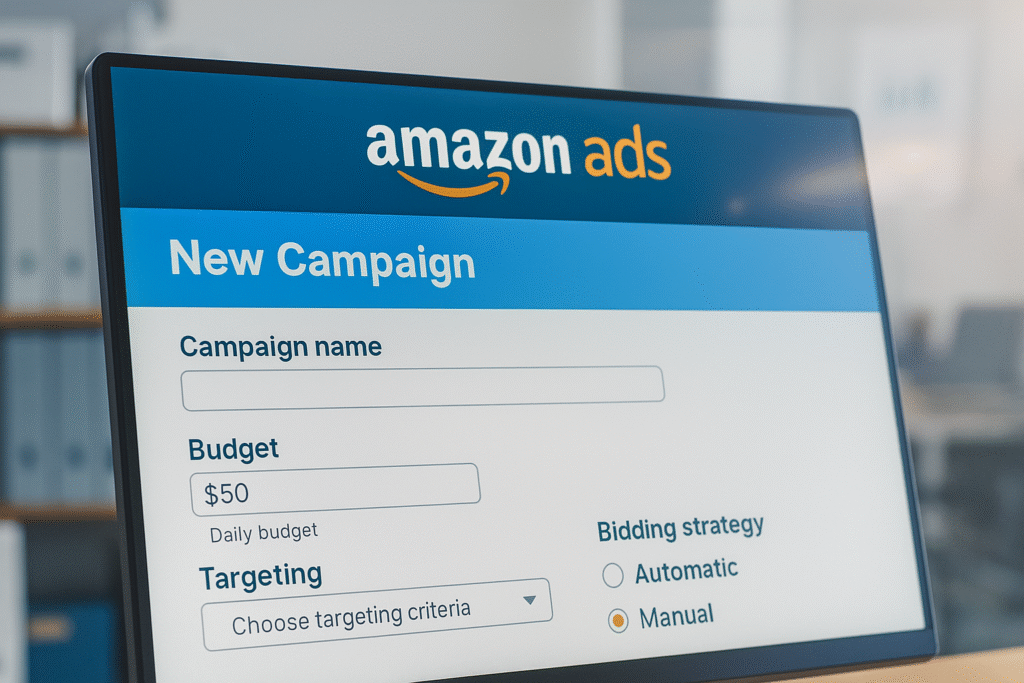Amazon PPC Campaign Types Explained: Which One Should You Choose?
Amazon PPC Campaign Types Explained
Table of Contents:
- What is Amazon PPC?
- Why Amazon PPC Campaigns Matter
- Types of Amazon PPC Campaigns
- Sponsored Product Campaigns
- Sponsored Brand Campaigns
- Sponsored Display Campaigns
- Sponsored Product Campaigns
- Amazon Auto Campaigns vs. Manual Campaigns
- Amazon Campaign Bidding Strategy Explained
- Building the Best Amazon PPC Strategy
- Optimizing Amazon PPC for Maximum ROI
- Common Mistakes in Amazon PPC Campaign Management
- Advanced Amazon PPC Campaign Strategy Tips
- Conclusion
- FAQs on Amazon PPC Campaigns
Introduction:
Running ads on Amazon is no longer optional—it’s essential. With millions of products competing for the same buyers, Amazon Pay-Per-Click (PPC) has become the most powerful tool to win visibility and sales. But the real challenge for sellers, brand owners, and small businesses is choosing the right campaign type.
Among the different types, Sponsored Product campaigns stand out as the most widely used. However, to build the best Amazon PPC strategy, sellers must also understand Sponsored Brands and Sponsored Display campaigns.
This guide will break down all types of Amazon PPC campaigns, how they work, when to use them, and how to optimize each one. By the end, you’ll know exactly which Amazon PPC campaign to choose for your brand and how to manage Amazon PPC effectively.
What is Amazon PPC?
Amazon PPC (Pay-Per-Click) is Amazon’s advertising model that allows sellers to bid on keywords or audience placements. Every time a shopper clicks your ad, you pay Amazon a fee. The goal is to drive visibility, increase conversions, and scale sales.
Amazon PPC ads appear in multiple places, including:
- Search results pages
- Product detail pages
- Amazon homepages (for certain ad types)
At its core, a PPCAmazon campaign is a way to pay for higher visibility, but the performance depends on keyword research, bidding, and campaign optimization.
| Campaign Type | Purpose | Best For |
| Sponsored Products | Promotes individual listings within Amazon search results and product pages. | Driving direct sales, launching new products, and competing for top keywords. |
| Sponsored Brands | Displays brand logo, custom headline, and product collection at the top of results. | Building brand visibility, introducing multiple products, boosting trust. |
| Sponsored Display | Targets audiences both on Amazon and off-site (retargeting + competitor targeting). | Retargeting past visitors, protecting brand, and winning customers from competitors. |
| Sponsored Video Ads | Short autoplay videos that appear in search results or product detail pages. | Engaging storytelling, increasing product awareness, boosting CTR (click-through-rate). |
Why Amazon PPC Campaigns Matter:
Amazon’s marketplace is crowded. Even if your product is high quality, it can get buried under competitors without proper promotion. That’s where Amazon campaigns come in.
Benefits of Amazon PPC:
- Visibility boost: Appear in top search results.
- Sales growth: Drive direct sales with measurable ROI.
- Data insights: Learn which keywords convert.
- Brand building: Establish trust with Sponsored Brands.L
Competitive edge: Outrank competitors with smart bidding.
Types of Amazon PPC Campaigns:
There are three main types of Amazon PPC campaigns every seller should know. Each serves a different purpose in your Amazon PPC campaign strategy.
Sponsored Product Campaigns:
Sponsored Product campaigns are the backbone of Amazon advertising. They are cost-per-click ads that appear within search results and on product detail pages.
Key Features:
- Keyword or product targeting.
- Ads look similar to organic listings.
- Work well for driving direct sales.
When to Use:
- Launching a new product.
- Competing for high-volume keywords.
- Improving organic ranking over time.
Example: A new supplement seller runs Sponsored Product campaigns targeting “best vitamin C tablets” to appear above competitors.
Sponsored Brand Campaigns:
Sponsored Brand campaigns (formerly Headline Search Ads) highlight your brand with a logo, headline, and product selection.
Key Features:
- Appear at the top of search results.
- Showcase multiple products at once.
- Drive traffic to a Storefront or product page.
When to Use:
- Building brand awareness.
- Promoting product bundles.
Cross-selling across your catalog
Sponsored Display Campaigns:
Sponsored Display campaigns extend your reach beyond Amazon by retargeting audiences.
Key Features:
- Appear on product pages, Amazon homepages, and external sites.
- Target shoppers who viewed your products or similar products.
- Support remarketing strategies.
When to Use:
- Retargeting cart abandoners.
- Winning back customers who viewed competitor listings.
- Expanding brand presence outside Amazon.
Amazon Auto Campaigns vs. Manual Campaigns:
When setting up amazon ppc campaigns, sellers must choose between automatic and manual targeting.
Amazon PPC Automatic Campaign:
Amazon automatically matches your product to keywords and placements. Great for beginners or for keyword discovery.
Pros:
- Easy setup.
- Broad reach.
- Discover new keywords.
Cons:
- Less control.
- Can waste budget on irrelevant clicks.
Manual Amazon Campaigns:
You select exact keywords or product targets. Requires research but allows greater control.
Pros:
- Target high-converting keywords.
- Adjust bids individually.
- Better optimization.
Cons:
- More time-consuming.
- Requires data analysis.
Best Practice: Run both auto and manual campaigns. Use auto campaigns to find new keywords, then transfer top performers to manual campaigns.

Amazon Campaign Bidding Strategy Explained:
A strong campaign bidding strategy Amazon can make or break your ads. Amazon offers three bidding options:
- Dynamic Bids – Down Only
Amazon lowers your bid when a click is less likely to convert. Safe but conservative. - Dynamic Bids – Up and Down
Amazon increases or decreases your bid based on conversion likelihood. More aggressive but can drive higher sales. - Fixed Bids
Your set bid never changes. Maximum control but no AI adjustment.
Best Approach: Start with “Up and Down” for testing, then switch to “Down Only” for stability.
Building the Best Amazon PPC Strategy:
Creating the best Amazon PPC strategy requires combining campaign types and smart bidding.
Steps:
- Run Sponsored Product campaigns for direct conversions.
- Add Sponsored Brand campaigns for awareness.
- Retarget with Sponsored Display campaigns.
- Test both auto and manual campaigns.
- Use data to refine keyword lists.
- Adjust bids based on ROI.
| Bidding Strategy | How It Works | When To Use |
| Dynamic Bids (Down Only) | Amazon lowers your bid when a click is less likely to convert, helping control wasted spend. | Great for cautious advertisers, new sellers testing campaigns, and low budgets. |
| Dynamic Bids (Up & Down) | Amazon increases or decreases your bid in real time depending on conversion likelihood. | Best for aggressive sellers during high sales periods (Prime Day, Black Friday). |
| Fixed Bids | Amazon uses your exact set bid without changes, giving you complete control. | Useful for keyword testing, analyzing new markets, or comparing performance. |
| Rule-Based Bidding | Advertisers apply their own rules (manual adjustments) to change bids strategically. | Advanced sellers who want full control with their own bid management style. |
Optimizing Amazon PPC for Maximum ROI:
Optimizing Amazon PPC is an ongoing process. It’s not enough to set campaigns and forget them.
Key Optimization Tactics:
- Negative keywords: Block irrelevant traffic.
- Bid adjustments: Raise bids on profitable keywords.
- Dayparting: Run ads at peak shopping hours.
- A/B testing: Try different headlines or creatives.
- Budget allocation: Shift budget to best-performing campaigns.
Common Mistakes in Amazon PPC Campaign Management
Even advanced sellers make mistakes in Amazon PPC campaign management.
- Launching only auto campaigns without manual.
- Ignoring campaign reports.
- Bidding too high on unproven keywords.
- Not using negative keywords.
- Failing to separate branded vs. non-branded keywords
Advanced Amazon PPC Campaign Strategy Tips:
For sellers ready to scale, these advanced tactics can transform results.
- Segment campaigns by match type (broad, phrase, exact).
- Run product targeting ads on competitor listings.
- Test different campaign bidding strategies.
- Use Sponsored Display to cross-sell within your catalog.
- Leverage long-tail keywords for cheaper clicks.

Conclusion:
Amazon PPC can be the difference between a product that sits unnoticed and one that becomes a bestseller. From Sponsored Product campaigns to advanced bidding strategies, every seller must understand the campaign types and how to use them.
Start small, test both auto and manual campaigns, and refine your approach with data. The right Amazon PPC campaign strategy will not only boost sales but also build long-term brand visibility.
👉 Ready to take action? Comment your thoughts below, share this guide with other Amazon sellers, and subscribe for more growth insights
What is the difference between Sponsored Product and Sponsored Brand campaigns?
Are Amazon auto campaigns worth it?
How much budget do I need for Amazon PPC?
Which Amazon PPC campaign type is best for beginners?
How do I manage Amazon PPC effectively?
Recent Posts
- All Post
- Amazon Compliance
- Amazon FBA Guide
- amazon market analysis
- Amazon PPC
- Amazon Stock
- Amazon Tools
- Business Strategy
- Ecommerce News & Analysis
- Full Account Management Services
- Guide
- Guide 2025
- News
- News 2026
- PPC Services
- Prime day
- Stories
- Team Memebers
- Technology and Digital Services
- Top Agencies
- Top PPC tools



Get a Quick Solution
Need help fast? Our expert team is here to provide you with efficient and reliable solutions tailored to your needs. Don’t wait—reach out today!
Categories
- Amazon Compliance (5)
- Amazon FBA Guide (6)
- amazon market analysis (2)
- Amazon PPC (30)
- Amazon Stock (1)
- Amazon Tools (1)
- Business Strategy (12)
- Ecommerce News & Analysis (6)
- Full Account Management Services (58)
- Guide 2025 (20)
- News 2026 (12)
- PPC Services (58)
- Prime day (2)
- Technology and Digital Services (1)
- Top PPC tools (1)
Subscribe for Growth Tips, Seller Hacks & eCom Wins


